Top 18 Exercises with Resistance Band for Full Body Workout
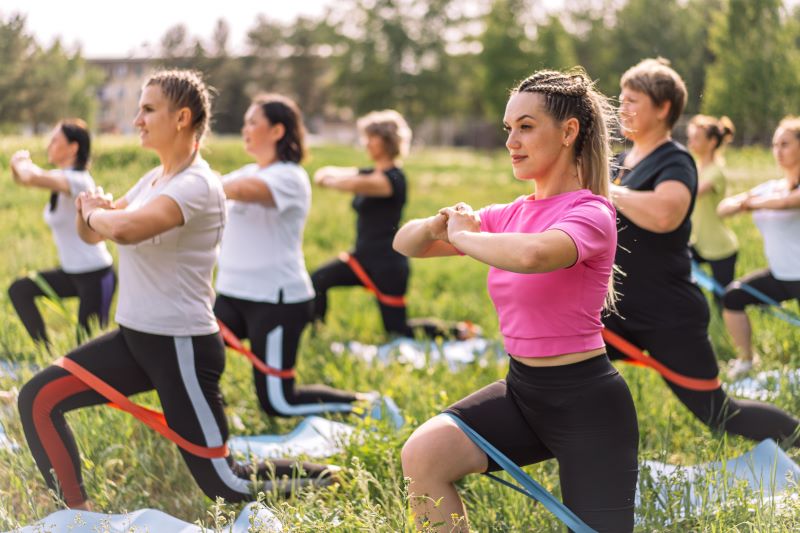
The most effective and affordable workout equipment you can get is resistance bands. Resistance band workouts may provide a nice challenge for your muscles, regardless of your fitness level, whether you are a novice or well accomplished.
Exercises using resistance bands may appear simple initially, but they significantly benefit strength training. Hence, a full-body resistance band workout might be the right choice to train your muscles.

Table of Contents

What are Resistance Band Exercises?
An elastic band used for strength training is called a resistance band. They are also frequently used in physical therapy, particularly by patients recovering from muscular injuries, such as those undergoing cardiac rehabilitation, to facilitate the gradual regrowth of strength.
Resistance band training has become increasingly popular because it is a low-impact method of full-body exercise. Resistance bands lessen the chance of damage because they do not exert pressure on joints like free weights. \
18 Best Resistance Band Exercises
Resistance band exercises are the best methods to train your full body. So, here is the list of best full-body resistance band exercises that you can do to work your full body:
Core Exercises
Resistance bands add controlled challenge to core exercises, making them more effective at strengthening your abs and improving overall core stability. Here are a few core exercises you can do with the help of a resistant band:
1. Russian Band Twist
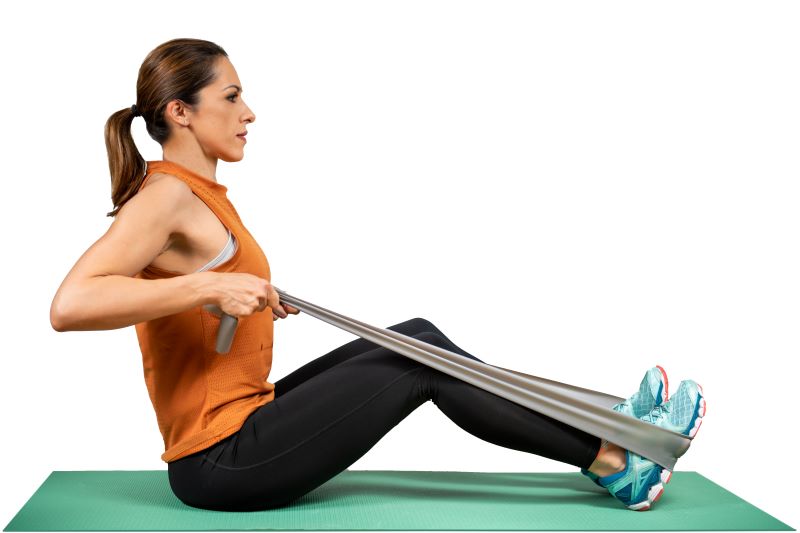
A Russian band twist causes escalating resistance, which will effectively work your obliques more than a medicine ball. Simply make sure there is no slack in it while performing it continuously.
- Place your feet flat on the ground and cross them for this exercise.
- Then, holding either end with your hands, wrap the resistance band around your feet.
- After that, turn quickly from side to side while quickly twisting the torso.
2. Band Plank With Row
The band plank with a row is an excellent exercise for building core strength and back muscles. It challenges your stability while working your core and back, making it practical for a toned midsection and more muscular upper body.
Start with securing the band to a post.
Then, assume a plank position with your glutes and core contracted.
After that, maintain a flat lower back by reaching forward with one arm, gripping the handle, and controllably rowing it to your rib cage and back.
3. Band Horizontal Wood Chop
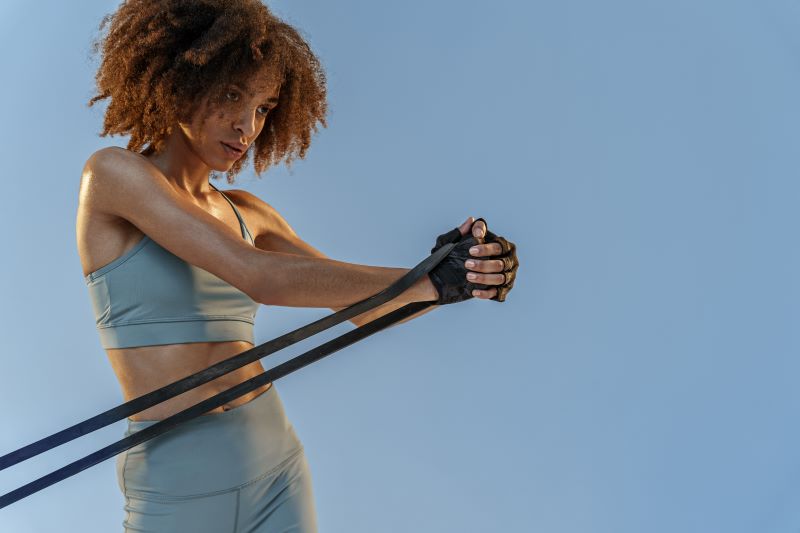
This fantastic functional core workout shakes your abs and obliques as you rotate through each rep. It mimics a rotational movement in daily activities, improving overall strength and stability.
Grab the band’s end with both hands while standing sideways and secure it to a post.
Then, pull the band across the body while twisting your torso with your arms fully extended.
Finally, return to the starting position gradually and safely.
4. Banded Bridge
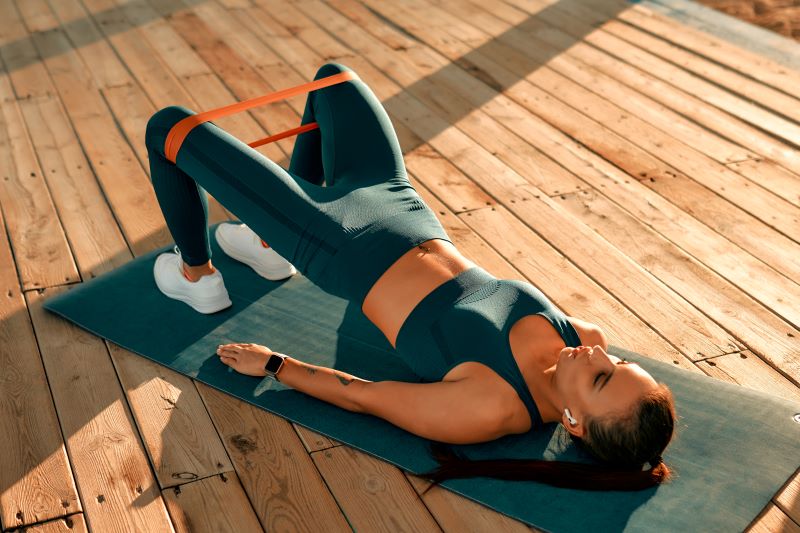
The resistance band adds extra resistance, making the bridge exercise more challenging and effective for targeting the glute muscles. Strengthening the muscles around the hips and lower back can help improve overall posture and spinal alignment.
Lay faceup on the ground with a little band around your thighs, your heels as close to your hips as comfortable, around shoulder distance apart.
Maintaining your shoulder blades on the ground, raise your hips and slightly extend your knees.
Twist the spine back down while keeping a deep scoop in the abdomen.
Do 10 reps in 2 sets.
Chest Exercises
Resistance bands are great for chest exercises as they provide constant tension throughout the movement, helping build strength and muscle. They're also versatile and portable, allowing you to get a chest workout anywhere.
5. Band Chest Press
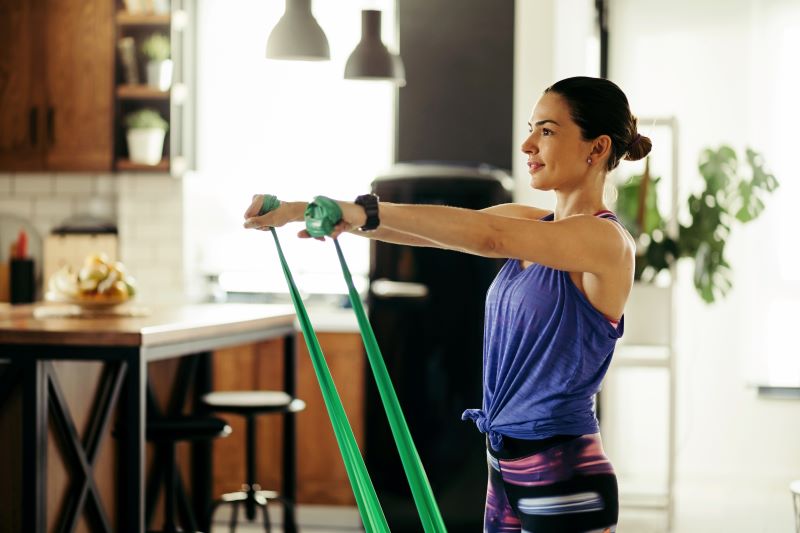
It is a good exercise for building chest strength, offering variable resistance that mimics a free-weight press. It's great for beginners or those on the go, but advanced trainers may need heavier weights.
By holding both grips with your upper arms in contact with the floor, place a resistance band beneath your shoulders.
Then, pull the band up with both arms as you extend it until it is straight. Repeat by lowering it back to its initial position.
6. Banded Push-Ups
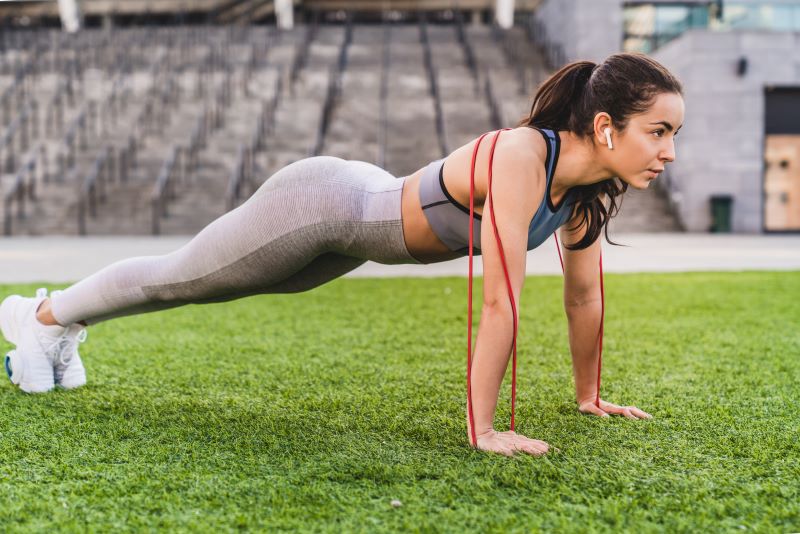
Banded push-ups are highly effective for building upper body strength as the band adds resistance throughout the movement, challenging you more than regular push-ups. They can also improve push-up form and protect your shoulders from injury.
The band should first be wrapped around your back.
Hold the band firmly with both hands and exercise like a typical push-up, but in this case, emphasise strength.
Drive your hands into the ground while explosively pushing your body up into full lockout before resuming the starting position.
7. Resistance Band Fly

In this exercise, the resistance band provides resistance throughout the movement, effectively targeting the chest muscles, particularly the pectoralis major. These steps will help you perform it.
Anchor the resistance band at chest height, as you did for the chest press exercise.
Hold one end of the resistance band in each hand and step away from the anchor point until you feel the tension in the band.
Stand with your feet shoulder-width apart and your back straight.
Keep a slight bend in your elbows, open your arms to the sides in a wide arc, squeeze your chest muscles at the top of the movement, and return to the starting position.
Back and Shoulders Exercises
Resistance bands offer progressive overload for the back and shoulders, letting you build strength at home. Their variable resistance and ability to target specific muscles make them great for a versatile upper-body workout.
8. Band Shoulder Press
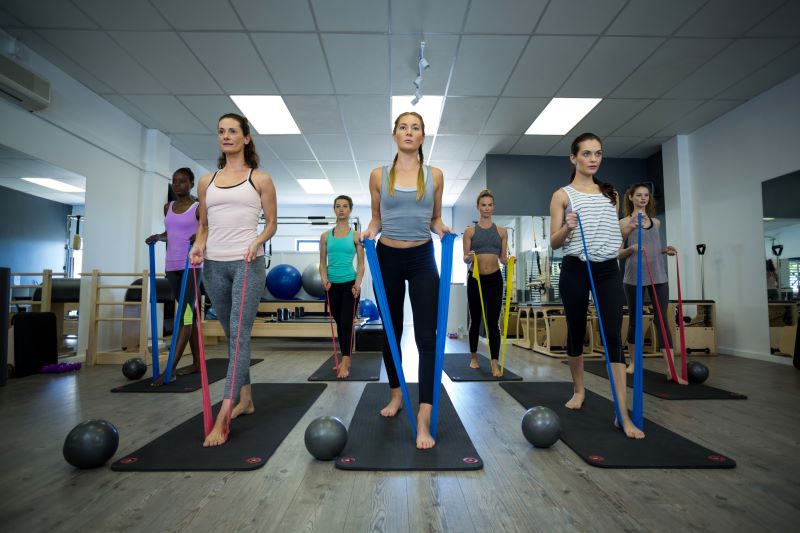
The band shoulder press is a great way to build shoulder strength and stability. Resistance bands provide constant tension throughout the movement, effectively targeting your muscles.
Stand on a resistance band and grip the other end with your palms facing forward at shoulder height.
Then, set your arms out in front of you shoulder-width apart.
Finally, repeat by bringing the band back down.
9. Upright Band Row
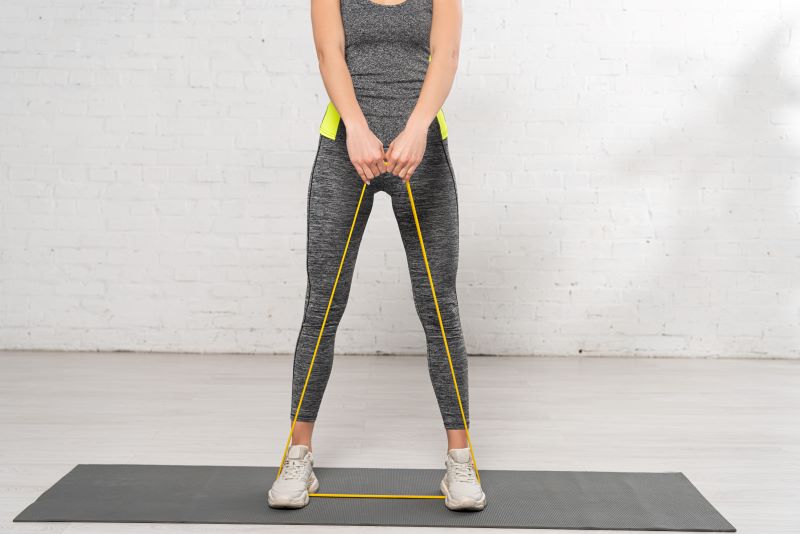
Upright band rows with resistance bands are a convenient and effective way to build more muscular shoulders and upper back muscles at home. They offer a good workout but require proper form to avoid shoulder strain.
Stand on a resistance band, lay your palms on your thighs, and hold the grips with the palms facing inward.
Then, lift the band toward your chin while maintaining the back straight and your elbows higher than your forearms.
Lastly, repeat the original posture to complete the exercise.
10. Band Bent-Over Row
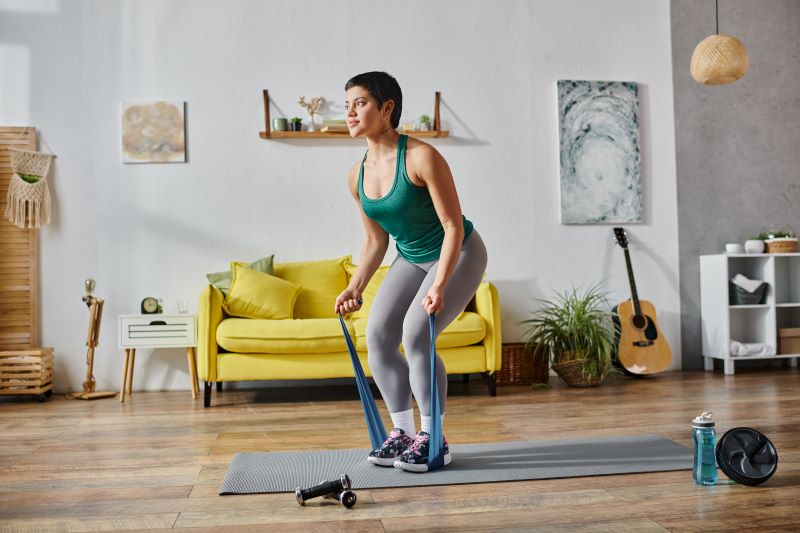
With the banded bent-over row, you'll stabilise muscles like your biceps, forearms, and shoulders. You'll also target your rhomboids and lats. Your posture and spine will be supported, preventing lower back issues.
While standing on a resistance band, you must keep holding both grips below your knee and lean forward a little.
Then, lift the band up towards your upper rib by tightening the muscles in your shoulder blades.
Finally, repeat after lowering the band.
11. Band Reverse Fly
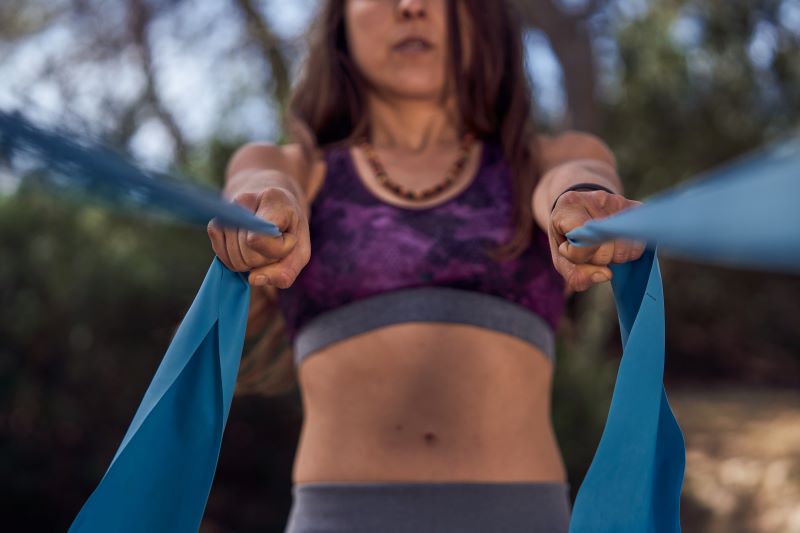
The band reverse fly with a resistance band is a very effective exercise for strengthening your posterior shoulder muscles, particularly the rear deltoids, which help improve posture and shoulder health.
Loop a resistance band around an anchor point (door knob, pole) and hold the ends with palms facing each other.
Then, with a slight bend in your elbows, raise your arms to the sides until shoulder blades are squeezed together, then lower back down slowly.
Arms Exercises
Resistance bands offer progressive resistance throughout arm curls, extensions, and other exercises, maximising muscle engagement and building strength. They're also lightweight and versatile, letting you target various arm muscles at home or anywhere.
12. Band Hammer Curl
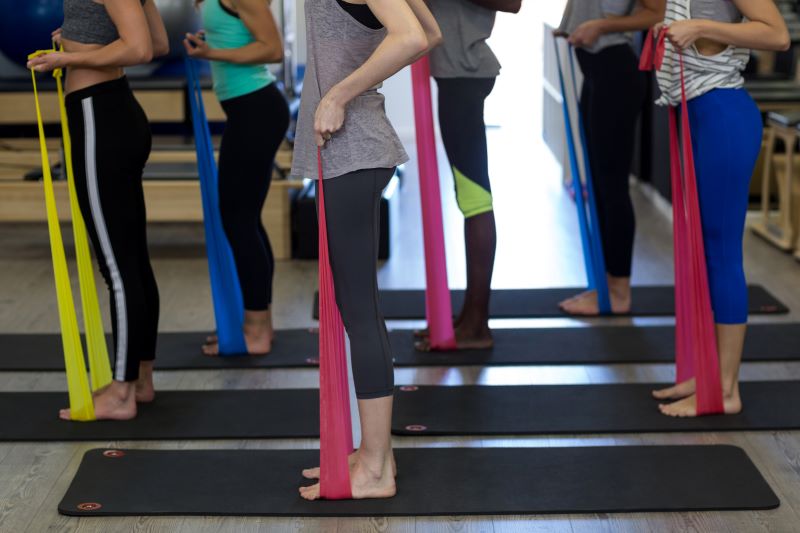
Banded hammer curls work several stabilising muscles, including your delts and traps, and working your forearms and strengthening your grip. For the execution, follow the steps mentioned here.
Ensure that your elbows are tightly positioned against your body.
Hold each side while standing on a resistance band with your palms towards your hips.
Keep your palm in place as you curl up until your shoulders are just over your thumbs.
Then, bring it back down to where it was before.
13. Band Tricep Kickback
Band tricep kickbacks are a great exercise for isolating and strengthening your triceps. The resistance band provides constant tension throughout the movement, leading to effective muscle toning.
Hold the handle of your resistance band with one hand, palm facing in, and fasten it to something at waist height.
Remember that your knees should be slightly bent as you lean forward at the waist to lower your back while maintaining it straight.
Then, pull the band behind you using your triceps until your arm is completely stretched. Pause, lower, and then repeat.
14. Band Concentration Curl
Band concentration curls are great for isolating and strengthening your biceps. The resistance band provides constant tension throughout the curl, leading to effective muscle building.
Firstly, step onto the resistance band while holding one of the handles in your hand and your elbow on your thigh.
Then, bend your back slightly as you lean forward. After that, curl the band as far as it will go while keeping your upper arms stationary.
Lastly, repeat by lowering it again.
15. Band Bicep Curls
Band bicep curls are a great way to build biceps. The constant band tension challenges your muscles throughout the curl, leading to effective muscle growth.
Hold the resistance band with an underhand grip while standing on it about shoulder-width apart.
Then, curl the band so that your forearms are in contact with your biceps and it is parallel to your collarbone.
Finally, repeat after lowering.
Legs Exercises
Resistance bands offer a portable and effective way to strengthen your legs. They challenge multiple muscles throughout the movement, improving leg strength, stability, and flexibility.
16. Band Squat
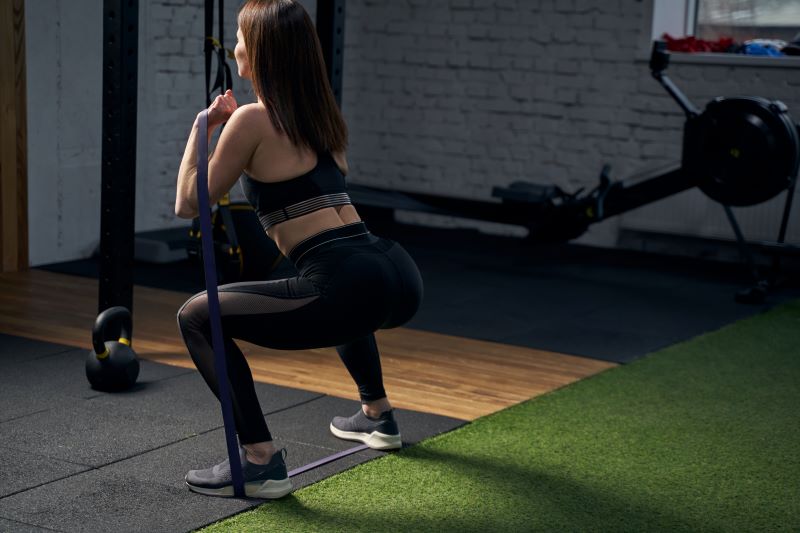
Band squats with resistance bands are a very effective way to build lower body strength and improve posture. They provide constant tension throughout the movement, challenging your muscles throughout the squat.
Place a resistance band under the feet and squat down.
Your palms should be facing inward while you hold each handle at the side of your body.
Then, pull the band up until it is parallel to your thighs as you push up to straighten your legs.
Drop down and do it again.
17. Band Thrusters
Banded thrusters, which combine a squat and an overhead press, offer excellent value. In addition to working your hamstrings, quads, and shoulders, they also raise your heart rate, which improves your fitness.
Hold either end of the resistance band with your hands and stand on it with your feet shoulder-width apart.
Bring your hands to your shoulders as the band descends behind your shoulders.
Then, squat down while bracing your core and maintaining your chest up, then explode upwards.
After that, push the resistance bands above as you first stand up and then gently drop your arms.
18. Resistance Band Lateral Walks
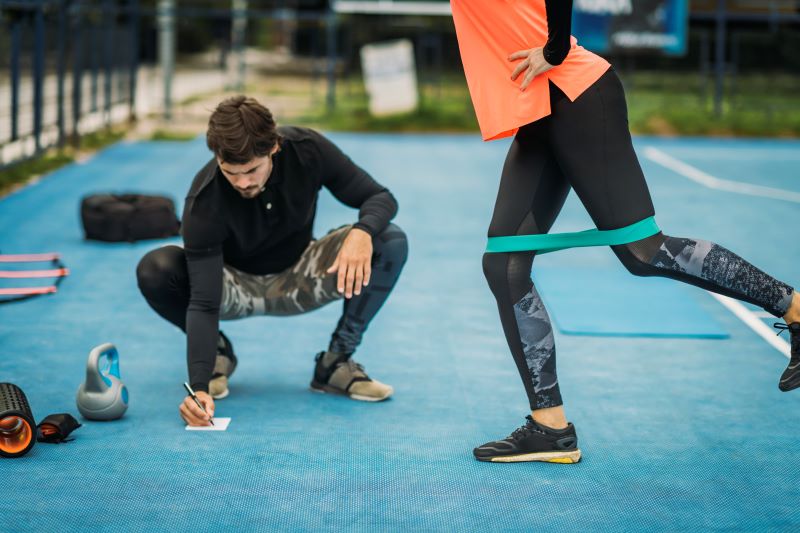
Lateral walks primarily target the hip abductor muscles, including the gluteus medius and minimus, which are important for hip stability and overall lower body strength. Adjust the intensity of the exercise by using a lighter or heavier resistance band.
Place a resistance band around your legs, just above your knees. Stand with your feet hip-width apart and slightly bend your knees.
Take a small step to the side with your right foot, keeping tension on the resistance band. Follow with your left foot, bringing your feet back to hip-width apart.
Continue stepping sideways, leading with the same foot for several steps.
Different Types of Resistance Bands
Before starting exercises using resistance bands, knowing their classification for better results is essential. Below are the 5 types of resistance bands that you can find:
- Power Resistance Bands or Loop Bands: Power resistance loop bands are like thick rubber bands in a loop shape. They can be used for stretching, full-body workouts, therapy, and warm-ups. They can also be attached to poles for rehab exercises that involve pulling and pushing. These bands are versatile and suitable for all types of training, from sports to bodybuilding.
- Rubber Mini-Bands & Fabric Non-Slip Hip Circle Bands: These are like power resistance loop bands but shorter and wider. Use them to strengthen and stabilise your lower and upper body. Place them above your knees or ankles to activate your hips and glutes. They're great for weightlifting and help with core stability, proper form, and extra tension during exercises like squats and leg extensions.
- Tube Resistance Bands With Handles: The handles are like those on gym equipment, perfect for chest presses, ba tear ck rows, curls, and shoulder presses. They are great for people who need gym access or who like to work out outdoors. These bands are portable and can be used for all muscle groups.
- Figure 8 Bands: Figure 8 bands look just like the name suggests, with soft handles at the top and bottom for gripping. You can stretch them to work both your upper and lower body. They can also be used like mini bands for side-to-side movements. These bands are great for exercises mimicking machine and dumbbell workouts, especially for pulling and pushing.
- Light Therapy Resistance Bands: Therapy bands are long, straight bands up to 7 feet long, ideal for seniors and people recovering from injuries. They provide low-impact resistance and are great for pilates and fat-burning exercises. They can also assist you in extending your stretch and enhancing your mobility and range of motion.
Benefits of Doing Resistance Band Exercises
Using resistance bands for performing exercises has manifold advantages. Some of the most notable benefits of resistance band exercises for full body are provided below:
Resistance band workouts are ideal for static stretching and cooling down after workouts.
These are also beneficial for mobility and warming up.
Resistance bands are ideal for you if you want to start exercises at home.
Using resistance bands for metabolite training allows you to safely perform large rep volumes with brief rest intervals between sets while maintaining continual stress on your muscles.
Resistance bands are the perfect tool for weight loss and muscle building.
Resistance bands are ideal for plyometric training. If you're exercising alone, anchor the band and start performing resistant box jumps, resisted push-ups, and many more exercises to burn heaps of fat and build lean muscle.
Resistance bands are adaptable regarding their uses and advantages and the range of workouts that may be performed. Bands can strike frontal, sagittal, and transverse axes of motion.
Resistance bands may significantly increase the difficulty and entirely alter the dynamics of basic exercises like bench presses, squats, and deadlifts.
Resistance bands are ideal for helping with bodyweight exercises like dips, pull-ups, and push-ups, as well as many other callisthenics exercises.
Resistance bands are excellent for injury recovery. As with weightlifting, you may use them to strengthen your motions in the first place without putting as much strain on your joints and spine.
What are the Resistance Band Exercises You Should Avoid?
There aren't necessarily exercises you should completely avoid with resistance bands, but there are some to be cautious with due to the potential for injury if not performed correctly.
- Band Pull-Apart: While it's a great exercise for shoulder stability and posture, overdoing it or using too much resistance can strain the shoulder joints.
- Band Pull-Through: It's fantastic for targeting the glutes and hamstrings, but improper form, like rounding the lower back, can lead to back strain.
- Band Deadlift: Band Deadlifts are effective for lower body strength, but if done with poor form or too heavy resistance, they can strain the lower back.
- Band Chest Fly: This is excellent for chest muscles, but overstretching the bands or using excessive resistance can strain the shoulders. Always prioritise proper form and start with lighter resistance to avoid injuries.
Safety Precautions for Resistance Band Exercises
Due to typical wear and tear from use, resistance bands can degrade over time. Hence, they should be regularly inspected to ensure they are in a safe functioning state. Nevertheless, here are a few things to consider for maintaining safety while using resistance band exercises:
- Never put the resistance band grips over your feet. They are simple to remove and hit the user.
- Full body resistance band training should be started carefully to establish band strength.
- Never unwind a resistance band while it is still taut. Because a release, when the band is under stress, might force it to snap back toward the user, seriously injuring them.
- Always check the handles and bands before each usage. Also, remember to examine the band for any signs of weakness, such as nicks, cuts, scratches, cracks, discolouration, or similar.
- Never try to fix a broken band and throw away the band right away if any defects are found.
- Do not jerk the band.
Disclaimer: Practice the above-mentioned exercises under the supervision of a trained practitioner and consult a doctor beforehand to ensure your body is fit enough to perform the required moves/postures.
A resistance band is a piece of equipment worth investing in regardless of your fitness level. A full-body resistance band workout can target any body portion without placing additional strain on the joints. Resistance band exercises may also be excellent for focusing on those smaller muscles that serve as stabilisers and targeting larger muscular groups.














